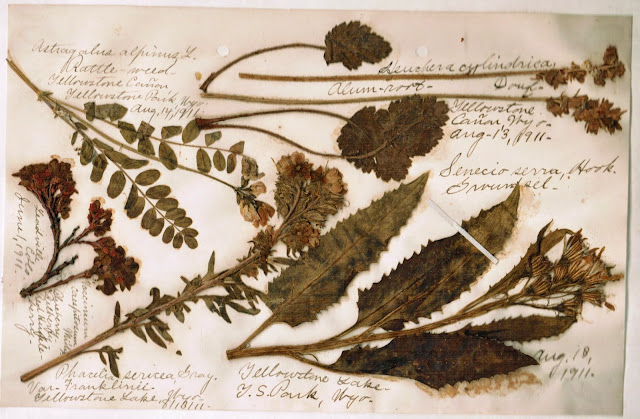 Here's a problem TPP has never had to deal with before. Our herbarium contains an unfiled folder of historically important specimens collected a bit over 100 years ago by Mary Strong Clemens, a famous plant collector, from places like Yellowstone National Park, but to be accessible, they need to be in the collection. The problem is that two to six different unrelated plants specimens are crowed onto 5" x 8" small pieces of mounting paper (the collector was probably short on paper) and labeled by hand right on the paper right next to the specimen. Now there are couple of possible solutions. First, you might attempt paper doll "surgery" to separate the specimens mounting the pieces of the original sheet on a new piece of mounting paper, but even with a careful hand this may not be easy or possible on all of these sheets, and aesthetically, it's a terrible solution. The solution that is leading the pack is to scan the specimens, like the above image, print it on archival paper and then file the "copies" in the right place for each specimen, but include a pointer on the photocopy "specimens" telling you where to find the "original", which will be filed correctly for one of the specimens. This sounds like a good little project for the next student intern to come along. Any other suggestions or solutions?
Here's a problem TPP has never had to deal with before. Our herbarium contains an unfiled folder of historically important specimens collected a bit over 100 years ago by Mary Strong Clemens, a famous plant collector, from places like Yellowstone National Park, but to be accessible, they need to be in the collection. The problem is that two to six different unrelated plants specimens are crowed onto 5" x 8" small pieces of mounting paper (the collector was probably short on paper) and labeled by hand right on the paper right next to the specimen. Now there are couple of possible solutions. First, you might attempt paper doll "surgery" to separate the specimens mounting the pieces of the original sheet on a new piece of mounting paper, but even with a careful hand this may not be easy or possible on all of these sheets, and aesthetically, it's a terrible solution. The solution that is leading the pack is to scan the specimens, like the above image, print it on archival paper and then file the "copies" in the right place for each specimen, but include a pointer on the photocopy "specimens" telling you where to find the "original", which will be filed correctly for one of the specimens. This sounds like a good little project for the next student intern to come along. Any other suggestions or solutions?
Change of address
5 months ago in Variety of Life
















3 comments:
You could have a totally digital catalog, with each and dispense with having placeholder copies filed in the "correct" locations for the additional specimens, provided that each record notes where the physical specimen is filed. I don't know whether you have a more substantial collection to integrate these with, but if you don't, going straight to a digitized collection will save time down the road. And you can put that online where it's accessible to other researchers.
This is what my institution's herbarium has done. I wish I could say that the parasitology department has done the same... it's a work in progress.
Ah well, how nice. Unfortunately the resources to accomplish this just do not exist. The collection is too big to do this easily or in a reasonable period of time, and yet too small to attract the necessary funding.
Scanning the originals may cause damage (many scanners require the flat bed lid to close down onto the paper before scanning). Consider using a high end personal digital camera instead as the images will likely turn out better than a scan. Store the photo files in at least two locations, or consider storing them in "cloud" storage like drop box or Google so the image files aren't lost if a computer breaks or someone deletes a folder.
Move the originals out of plain folders, and away from any modern paper as well. Archival-quality flat storage boxes will protect them from acid, etc.
Post a Comment